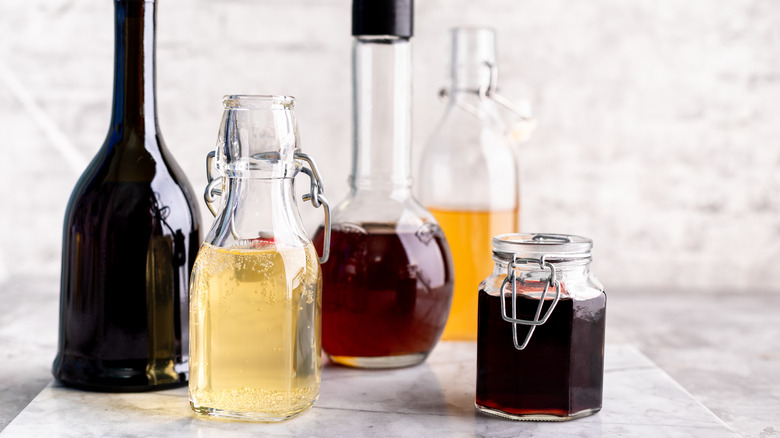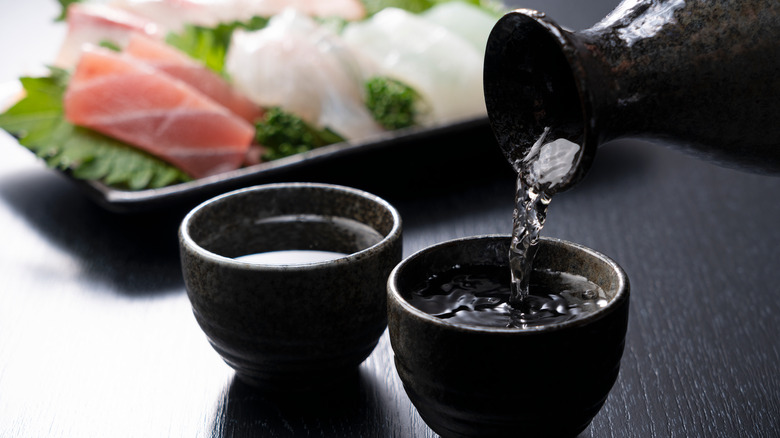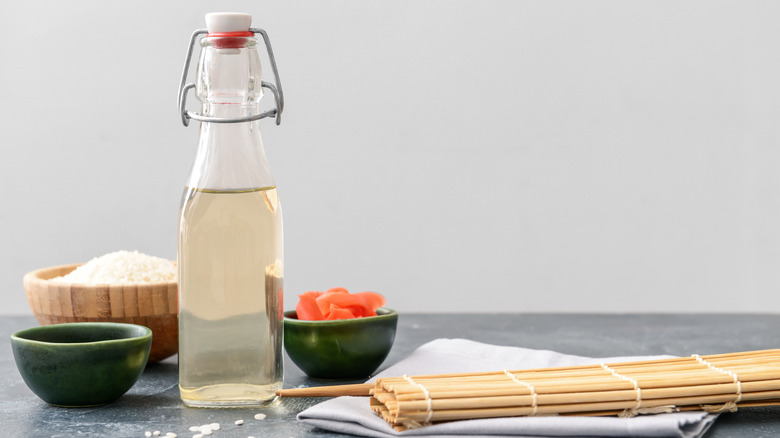Rice Wine Vs. Rice Vinegar: The Differences And When To Use Each
As a sustaining staple food for at least 3.5 billion people worldwide, it's no surprise that rice delivers tantalizing derivatives such as rice wines and rice vinegars. It's valid to assume some similarities in rice-centric wines and vinegars, but they have quite a few differences in flavor and applications. Both products derive from fermented rice starches, but the intricacies involved in the process lead to altogether different products.
For starters, rice wine is an alcoholic beverage, created by using active ingredients such as yeast, lactic acid bacteria, and fungi to turn starches into sugars and produce alcohol. Rice vinegar, on the other hand, results from using what's known as the "Mother of Vinegar" acid and minuscule amounts of rice wine. It's an acetic vinegar similar to numerous other vinegar products in just about every supermarket.
There's a somewhat misleading third category known as "rice wine vinegar," which is largely a labeling preference by some manufacturers, referring to those small bits of rice wine used in making some rice vinegar. But "rice vinegar" and "rice wine vinegar" are actually the same thing; neither of these labeled vinegars contain alcohol by the time they're bottled for consumption.
That's how the two products differ in constitution, but more important to most of us is how they taste and how to use each one.
Rice wine flavors, varieties, and how to use them
If you've ever sipped warm Japanese sake from small ceramic cups, you've tasted — and very likely enjoyed — rice wine. Sake is considered the national beverage of Japan, almost exclusively used for drinking rather than cooking.
A rice wine known as mirin is often favored for Japanese cooking, especially to enhance flavors in soy and teriyaki sauces, and to add complexity to fish or rice dishes. Its tangy sweet flavor makes it a good choice for marinades and glazes, and it works well in noodle-based stir-fry dishes.
Rice wines are generally sweet and mild, but some have stronger tastes depending on where they're made. Many Asian countries produce their own versions of rice wine, including Shaoxing wine, which often appears in Chinese and Taiwanese cooking. It's also popular for drinking due to high alcohol percentages of 18 to 25 percent. Other notable rice wines tied to specific regions include makkoli and dansul in South Korea, and a fruity, spicy, and sweet rice-wine derivative in Cambodia known as sombai.
The benefits and flavors of rice vinegars
Rice vinegar is rarely, if ever, considered a good substitute for recipes requiring rice wine. As with any vinegar, it bears an acidic structure with tangy, mouth-puckering flavor. However, sweetness is still a defining characteristic of most rice vinegars, similar to fruit-born apple or pear cider vinegars, or blackberry balsamic ones. It's also milder and less acidic than standard distilled white vinegar, making is a good choice for zesty salad dressings and homemade pickles or for pepping up steamed vegetables and sauces.
Rice vinegars come in an array of colors, mostly pale with light yellow tinges, but they can run darker depending on origin, the type of rice, and any added spices or herbs. For example, brown rice could lead to light copper tones in the rice vinegar, while a glutinous black sticky rice will likely result in darker hues with a umami flavor, especially when mixed with other types of grains.
Black rice vinegars are harder to find, but the effort may be worth the search. Glutinous black rice, also known as forbidden rice, is well-touted for its health-improving traits, including loads of antioxidants that rival the amount in blueberries. Cleveland Clinic notes potential benefits of black rice, such as boosting immunity and warding off diabetes and cardiovascular disease.



